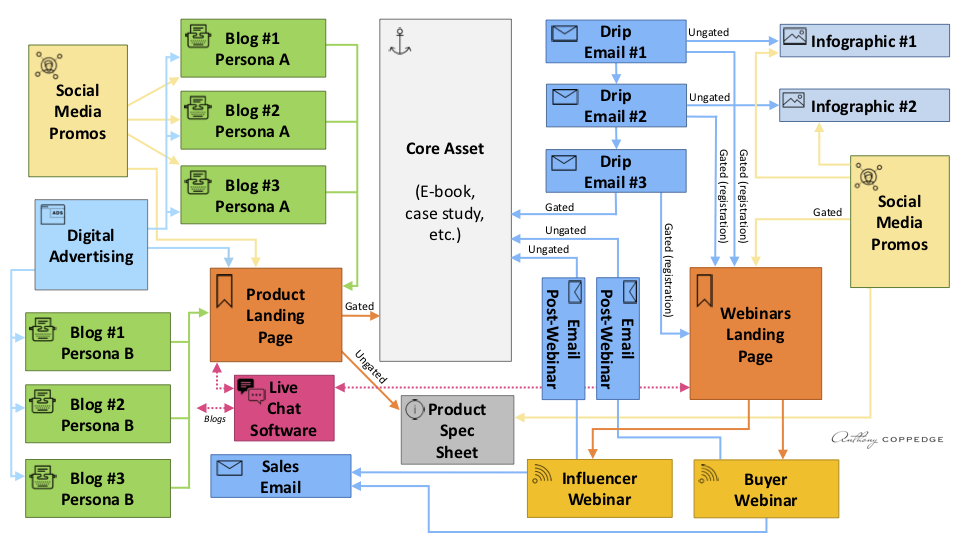The Vertical Market Customer Buying Journey
Helping prospects and clients inform themselves during their customer buying journey is not a one-size-fits-most process due to the exponential growth of online search. Instead of manufacturers and systems integrators publishing generic product features, benefits and specifications, today’s influencers and decision-makers are searching for how products work in their unique vertical markets and applications. To land high in search results, AV industry vendors must create unique vertical market customer buying journey maps to position well in relevant search results.
80/20 Rule for Vertical Markets
Fortunately, the 80/20 Rule can be applied to repurpose the majority of the product information when a Customer Journey Map (see below) is used to guide the process. While this monthly column is focused primarily on the House of Worship vertical market, the stats below and process described herein will virtually guarantee better lead qualification and higher conversion rates across every vertical market and market segment.
The need to build vertical market-focused content may seem daunting. Considering the major vertical markets of corporate, education, government, residential and non-profit, much less myriad segments such as healthcare, military, entertainment, higher education and the church market, it would seem overwhelming to make unique product spec sheets alone or even entire vertical market websites. However, much like the metaphor of ‘eating an elephant one bite at a time,’ there are helpful ways to divide up the work — and even reduce up to 80 percent of the workload.
The goal is to create multiple types of assets using a pattern that can be repurposed with minimal edits across all market segments and published to vertical market website landing pages. Build the majority (80 percent) of your product and service content once; then simply re-edit and repurpose those assets many times to build out a customer journey map unique to each vertical market segment.
The greatest benefit of repurposing your product information for vertical market applications is not in the time savings, but in the significantly higher page rank of online search for targeted vertical market content.
It is important to talk with your existing clients and capture key pain points and new opportunities per vertical market segment.
These insights, captured via customer service, marketing surveys and anecdotal conversations with salespeople will reveal how to craft compelling narratives for a series of blog posts aimed at two different personas in the research phase, inform unique email campaigns targeting specific user types with highly valuable, create targeted content to increase open and click-thru rates. The insights even help lay the groundwork for building unique landing pages so that search results for a particular product installation in churches will rank high in search results. Similarly, a landing page specific to the needs of higher education clients speaks directly to their purchase requisition process for a no-bid situation.
Repurposing Assets for Vertical Market Customer Journeys

The illustration above shows the opportunity to build out a customer journey map with assets created specifically for each vertical market segment, which is important considering the average number of research and information-gathering prior to purchasing hovers between six and eight touchpoints.
Salesforce, one of the worlds largest customer relationship management (CRM) platforms with over $10B in annual revenue, says it this way:
“The six to eight touches it takes to qualify a lead are crucial components of the lead nurturing process, allowing marketing the opportunity to educate and inform prospects as they move through each stage in the buying journey. These touch points are opportunities to prepare leads for the final stage in the buying journey, the point of decision-making. The better the experience and the more valuable each of these touch points are to leads, the more ready they’ll be to make a buying decision, and the more likely they are to convert to paying customers.”
For my friends in the AV industry in charge of sales and marketing, the illustration above also highlights the significant amount of coordination and back-end infrastructure required to orchestrate the creation of a successful customer journey map, with plenty of behind-the-scenes work to tie together CRM, CMS, ERP and third-party tools so that the many steps and touchpoints of the customer journey are captured and shared internally.
Unique Assets For Each Vertical Market
The customer buying journey for the House of Worship (HoW) market is defined into multiple segments. In much the same way education market is a large vertical comprised of pre-K, K-12, higher ed and trade schools, the church market is also made up of a variety of market segments such as mainline denominations, non-denominational, portable churches, multi-site churches and are even grouped by typical weekend attendance. The HoW vertical has many overlapping characteristics such as weekend services, large venues and are comprised largely of volunteers, yet the nuance and differences of the segments also provide a further targeting opportunity to identify unique pain points or common opportunities faced by certain subsets. Portable churches, for example, have a number of common needs similar to multi-site churches due to the fact that temporary venues are a common launch strategy for new campuses using the multi-site model. Finding similarities and identifying differences which resonate with the prospect is key to increasing viable leads and the pre-qualifying of prospects over time.
For both AV manufacturers and systems integrators, the teams that manage and own your product delivery are the same people who are ideally suited to help create the 80 percent of your content that is applicable to any market segment. For almost every AV marketing team, these are the same people who helped create the existing product spec sheets and product manuals. The difference between creating generic spec sheets and using a customer journey map is like a treasure map of an undisclosed island with an “x” to mark the spot, compared to a GPS map with the destination programmed in. The customer journey map includes the 80 percent portion of relevant information which applies regardless of the venue or client application for the product.
“The difference between creating generic spec sheets and creating a customer journey map is like a treasure map of an undisclosed island with an “x” to mark the spot, compared to a GPS map with the destination programmed in.”
The three images below visually illustrate the difference between the one-size-fits-all approach and how the 80/20 Rule applies well to the customer journey map so that each vertical market segment has unique, keyword specific content while maintaining the integrity of the overall asset.
Consider one of the most ubiquitous assets: spec sheets. The generic spec sheet was handed out at tradeshows and by sales reps back before dial-up internet. It’s been such a mainstay that we don’t often consider that it has become less and less relevant in its current form of feature, benefit, tech spec, blah, blah, blah. To make these effective again, the spec sheet needs to be created for each vertical market so that the application and unique value proposition is clear on a market segment by market segment basis.
The generic spec sheet illustrated above is still a good source for reproducible content, but it is far less effective than targeted spec sheets for two important reasons: first, it is almost always written as a one-size-fits-all, which is an approach that doesn’t address the unique pain points or opportunities for various market needs and second, generic content performs poorly for click-throughs, page dwell time and conversion rates, all of which are key factors to search engines like Google in determining the page rank in search results.

Illustration of a generic spec sheet
The next two illustrations include a unique identifier for the market segment and show the highlighted text from the generic copy which is easily repurposed with minor editing to create new, targeted content for each vertical market segment. The 80/20 Rule is visualized here to show that with a customer journey map it is possible to create valuable assets like targeted spec sheets, targeted market landing pages, customized emails per vertical segment and even core assets like case studies.

Illustration showing the highlighted 80 percent content which is relevant across markets, and the 20 percent unique content different for this vertical market segment (church).

Illustration showing the highlighted 80 percent content which is relevant across markets, and the 20 percent unique content per vertical market segment (government for this one).
The stats in favor of targeted content marketing are notable. Over the years, research has shown roughly 80 percent of business decision-makers prefer to get company information in a series of articles versus an advertisement and the website conversion rate is nearly six to ten times higher for targeted content marketing.
Start With The Assets You Have Today
Starting with a customer journey map, AV vendors have the ability to start where they are today and build out content and assets over time to create tighter areas of focus for the various vertical market segments. As the illustration above highlights, the strategy requires a high level of planning and coordination to create, curate and distribute unique, targeted content. It’s a lot of work, but it’s a lot of work that pays off with better search results, better education content for prospects and clients and better conversion rates to build better prospect funnels for the sales team.
To begin, itemize all of the existing assets for a particular product or product line. Look for the 80/20 Rule and highlight the content which applies to every market segment. This effort will yield a plethora of content fodder for building out smart, targeted campaigns and for creating unique landing pages, high-quality content giveaways. This initial effort will also lay the groundwork for creating webinars, infographics, e-books and case studies that are highly specific to the unique aspects of each vertical market segment.
Of course, the complexity of creating a customer journey map increases the work to strategically organize and deliver a robust execution across social media, digital advertising channels, and prospect tripwires and lead magnets, but that’s why collaboration between product owners, marketing and sales is vital.
Without the up-front diligence to create unique vertical market online experiences that result in high-ranking relevant search results and dramatically increase lead conversion rates, AV industry vendors stand to lose more than page rank; they’ll also lose more sales.
What do you think about Anthony Coppedge’s view of current trends? Does it represent what you’re seeing in the audiovisual industry or even your own company?





